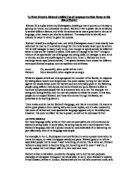Richard's villainy is both shocking and compelling
Discuss how Richard appeals to the audience in the opening two scenes?
Richard III opens with a soliloquy by Richard. Richard begins this with 'Now is the winter of our discontent', starting the speech with 'Now' gives it a sudden immediacy and makes the audience connect with Richard. Also its suggests that something has happened previously to this time which we know to be the murder of Henry VI by Richard. Richard says 'winter of our discontent’; we know that discontent is a longing for a situation better than the present. Also by saying 'winter', he is suggesting that his discontentment is at its worst point. This shows that throughout the play he will be striving to obtain a goal. It also shows us a glimpse of his personality which he shows as being impatient and dissatisfied with the world at present.
In this soliloquy Richard outlines his horrific plan to gain right to the throne. Shakespeare uses very powerful imagery to explain Richard's plot in a very emotive and connective way. He uses lots of poetic and dramatic devices to put emphasis on certain sections of the plot. He uses repetition of the keywords and phrases within the soliloquy to stress emphasis on particular words; an example of this is 'our' which Shakespeare uses a lot. This word is repeated so that the audiences feel continuously involved with Richard, this makes them feel obliged to like him because he is sharing his inner most secrets with them. Shakespeare also uses exaggeration to convince the audience to befriend Richard, he makes Richard insult him. When he does this he greatly over-exaggerates to show that he is not affected by harsh insults. He says that 'that dogs bark at me as I halt by them', this is hyperbolic because the dogs would not actually bark at him, however Shakespeare added this in so that the audience could look up to Richard because they would see him as a strong figure now that they know he can ignore verbal assaults. Richard describes his plan in great detail and is extremely casual about murder, this will strike the audience as somewhat sickening due to the exact detail that he provides and also that he seems to be slightly enjoying talking about the sickening actions, however the audience will also be intrigued by this; they will feel obliged to like him as he is such a powerful character, because he can talk about these things as if they were a normality, this astounds the audience because this will be a new encounter and this would portray Richard as a brave character for being able to say these things. Shakespeare also manages to hook the audience in by making Richard have such an unachievable plot that they are compelled to continue to follow the plan to see if his aim is actually obtainable. This further establishes a relationship between Richard and the audience because they are amazed that he has such self confidence to set such high aims.







